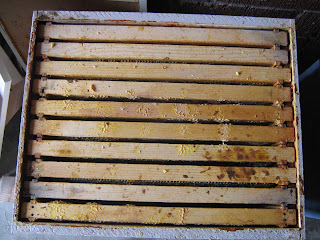This is a recipe I found online. My goal is to find a do-it-yourself solution to common disposable items in the home. This is my first time making dishwasher detergent and I can't tell the difference between this mix of ingredients and other name brands such as Seventh Generation, BioKleen, and Ecover. We use our dishwasher about once each week so this jar will last probably a year.
Recipe:
- 3 cups borax
- 3 cup washing soda
- 1 1/2 cup citric acid
- 1 1/2 cup kosher salt
This recipe fills my one gallon jar about half full. I use a small plastic scoop for filling the dishwasher. I found this random scoop in my laundry cupboard. A lid from a laundry detergent bottle or yogurt container would work just fine too.
**Update 3-27-2011** The jar I used didn't have an airtight seal---moisture got inside the jar which caused the powder to harden into one big rock. It took about an hour to chip away at this mass using a welding rod, but eventually I loosened it all up and transfered it to a better container with a tighter lid. Word of advice: use a container with a tight seal for storage!
A word about phosphate-free detergents:
In the past couple of years, there has been some hype about phosphates in detergents. I have been told that when they enter a natural waterway such as a stream, the phosphates absorb a high volume of oxygen in the water which increases algae growth. The reduction in oxygen creates an unbalanced ecosystem for fish and other oxygen-breathing organisms. Here in Portland, our sewer often overflows into our waterways when there is an abundance of rain. Even when phosphates enter modern wastewater treatment systems, breaking down phosphates is a very complicated process and nearly impossible to accomplish. I have been using phosphate-free detergents for years and haven't noticed any difference in the outcome. I don't have a lot of "whites" to wash, so the extra cleaning power that phosphates provides doesn't really matter to me. I would attempt to explain what the chemical properties of phosphates are, but I find it best to just quote what I've been finding online:
"One important function of phosphates in detergents is to enable the cleaning components of the
detergent to act, by preventing interference by the “hardness” of water (mineral ions). Even in soft water, this is necessary because of calcium and magnesium ions in soils and dirt. This function is termed “builder”. Phosphates also maintain the correct pH for cleaning components to act, in particular the high pH necessary to ensure sanitisation (killing of bacteria) in dishwashers." source
Do dishwashers really save energy?
I'm not convinced that dishwashers save electricity and water. I find literature and ads that say dishwashers are the better choice over hand-washing. Could these "fact givers" be salesman in disguise trying to sell products?
There are two main points to consider:
1. The hot water demand while hand-washing is a significantly shorter time period than the dishwasher---thus saving energy. I can complete a load of dishes by hand in 30 minutes or less, whereas my dishwasher takes about 2 hours. Any time during that 2 hours, I can turn on the kitchen faucet and have instant hot water which tells me the water heater is getting constant demand for 2 hours vs. 30 minutes.
2. Let's look at the entire lifecycle of the dishwasher. The lifecycle is a close analysis of the resources that go into a product, transportation, production, assembly, distribution, use, and where it goes when it's useful life is finished. Basically a cradle to grave analysis. So what if washing dishes by hand uses 4 gallons of water vs. a dishwasher that uses 3; look at the big picture, not just the number of gallons used. I doubt the entire lifecycle of a dishwasher is included in any of those literature brochures...
**Ironically, this very question was recently answered in the monthly newsletter we receive from our electric provider. My question about thermostat settings was also answered.



















